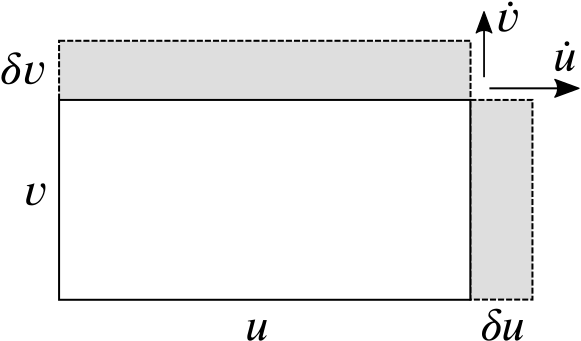
This white rectangle has a fixed height, \(v\), and width \(u\) which varies as a function of time, \(t\). We can write the rate of change of the width as \(\dfrac{du}{dt}\) or \(\dot{u}\). You can think of this as the speed at which the right hand edge is moving.
| The area of the white rectangle, \(A=\) | \(u\times v\) |
| In a short time interval, \(\delta t\), we can assume that \(\dot{u}\) is roughly constant, so thinking about speed and distance… | |
| The width increases by a small amount, \(\delta u =\) | \(\dot{u}\,\delta t\) |
| The area increases by the shaded area, \(\delta A =\) | \(v\times\dot{u}\,\delta t\) |
| The rate of change of the area of the rectangle, \(\dfrac{dA}{dt} \approx \dfrac{\delta A}{\delta t} =\) | \(v\times\dot{u} = v\dfrac{du}{dt}\) |
Note that \(\frac{\delta A}{\delta t}\) is a fraction whereas \(\frac{dA}{dt}\) is a derivative. They become identical in the limit as \(\delta t\to0\).
Our rectangle has height \(v=\quantity{3}{cm}\) and width \(u=\quantity{\left(\frac{1}{2}t^2+1\right)}{cm}\) at time \(\quantity{t}{s}\).
What is the rate of change of area, \(\dfrac{dA}{dt}\), at
\(t=0\)?
\(t=3\)?
Differentiating, we have \[\frac{du}{dt}=\frac{1}{2}\times2t = t\] so \[\frac{dA}{dt}=v\frac{du}{dt}=3t.\]
At \(t=0\), \(\frac{dA}{dt}=0\).
At \(t=3\), \(\frac{dA}{dt}=\quantity{9}{cm^2\,s^{-1}}\).

This white rectangle has width \(u\) and height \(v\), both of which vary as functions of time, \(t\). We can write the rates of change as \(\dot{u}\) and \(\dot{v}\).
| The area of the white rectangle, \(A=\) | \(u\times v\) |
| In a short time interval, \(\delta t\), we can assume that \(\dot{u}\) and \(\dot{v}\) are roughly constant, so… | |
| The width increases by \(\delta u =\) | \(\dot{u}\,\delta t\) |
| The height increases by \(\delta v =\) | \(\dot{v}\,\delta t\) |
| The area increases by approximately the shaded area, so \(\delta A \approx\) | \(v\times\dot{u}\,\delta t+u\times\dot{v}\,\delta t\) |
| The rate of change of the area of the rectangle, \(\dfrac{dA}{dt} \approx \dfrac{\delta A}{\delta t} \approx\) |
\(v\times\dot{u}+u\times\dot{v}\) \(= v\dfrac{du}{dt}+u\dfrac{dv}{dt}\) |
Note that in writing down \(\delta A\) we ignored the small white rectangle in the top right-hand corner. Why is it OK to do this?
This result is known as the Product Rule which is often expressed as \[\frac{d}{dx}\big(uv\big)=u\frac{dv}{dx}+v\frac{du}{dx}.\]
Our rectangle has \(v=\quantity{\sqrt{t+1}}{cm}\) and \(u=\quantity{\left(\frac{1}{2}t^2+1\right)}{cm}\) at time \(\quantity{t}{s}\).
What is the rate of change of area, \(\dfrac{dA}{dt}\), at
\(t=0\)?
\(t=3\)?
and so \[\frac{dA}{dt} = \left(\frac{1}{2}t^2+1\right)\times\frac{1}{2}(t+1)^{-\frac{1}{2}} + \sqrt{t+1}\times t.\]
At \(t=0\), \(\frac{dA}{dt} = 1\times\frac{1}{2}\times(1)^{-\frac{1}{2}}+0 = \quantity{\frac{1}{2}}{cm^2\,s^{-1}}\).
At \(t=3\), \(\frac{dA}{dt} = \left(\frac{9}{2}+1\right)\times\frac{1}{2}\times(4)^{-\frac{1}{2}}+\sqrt{4}\times 3 = \quantity{7\frac{3}{8}}{cm^2\,s^{-1}}\).

